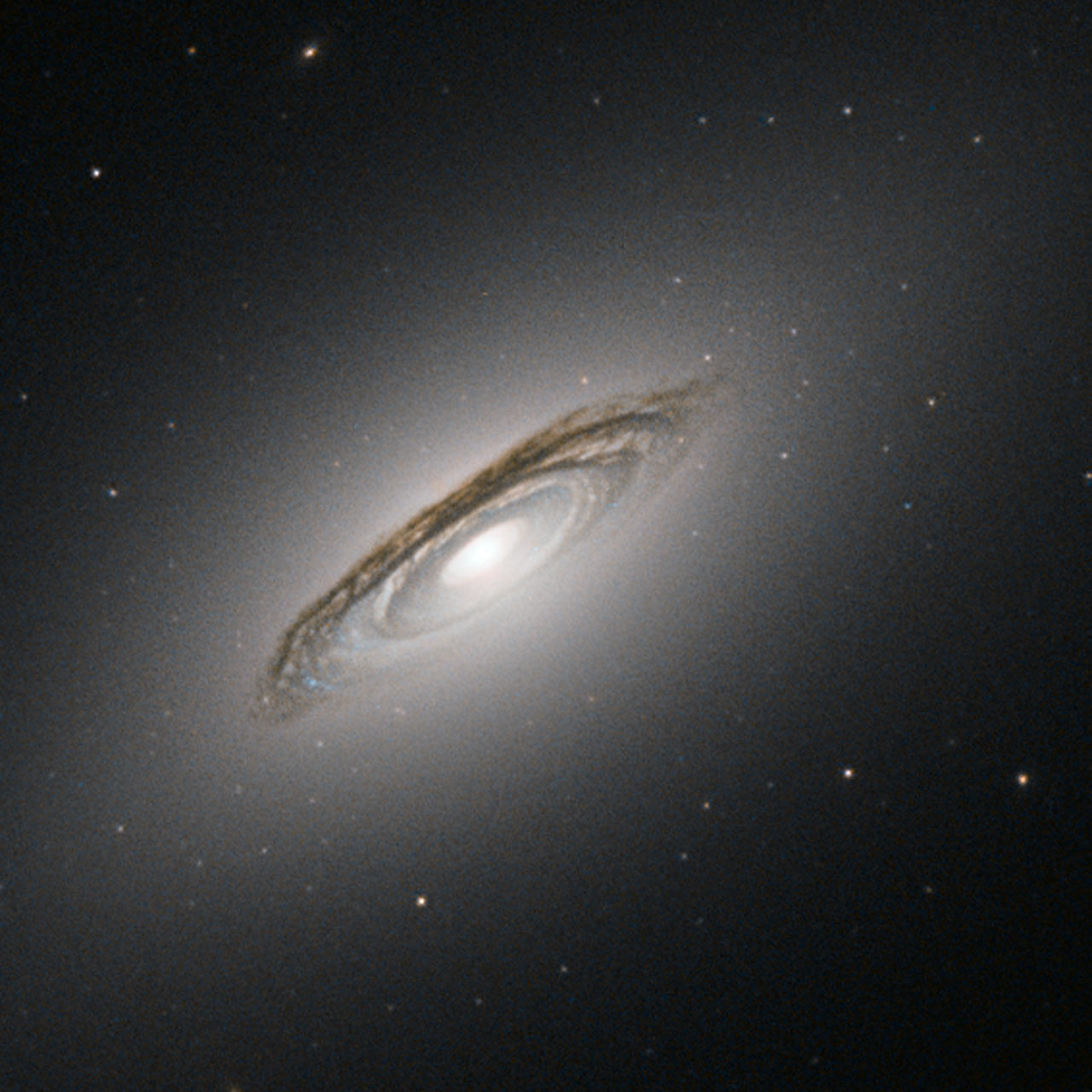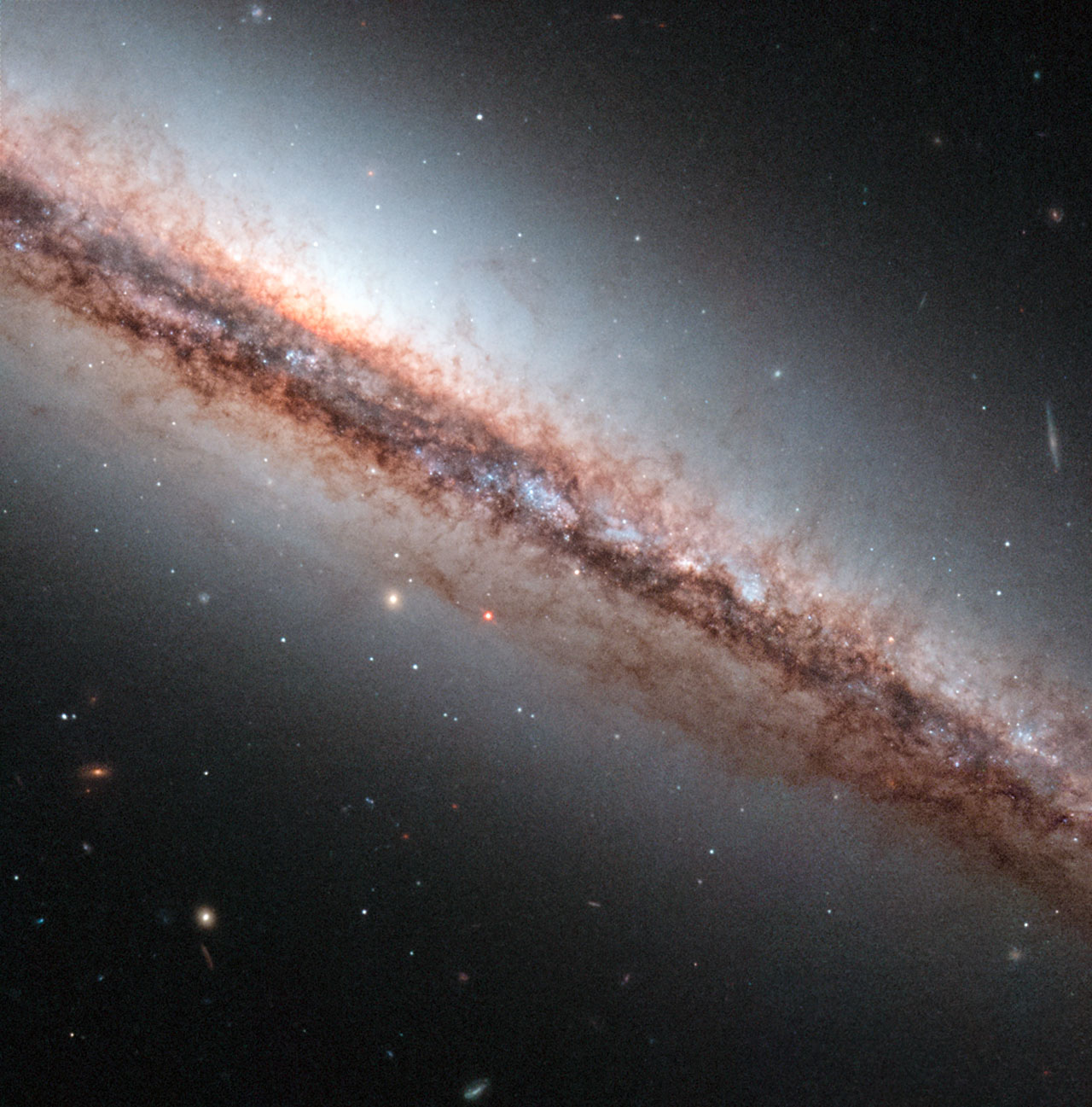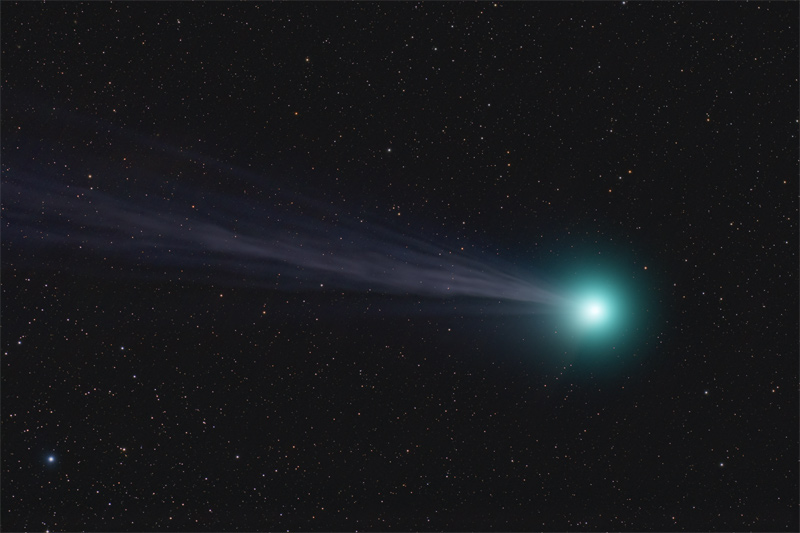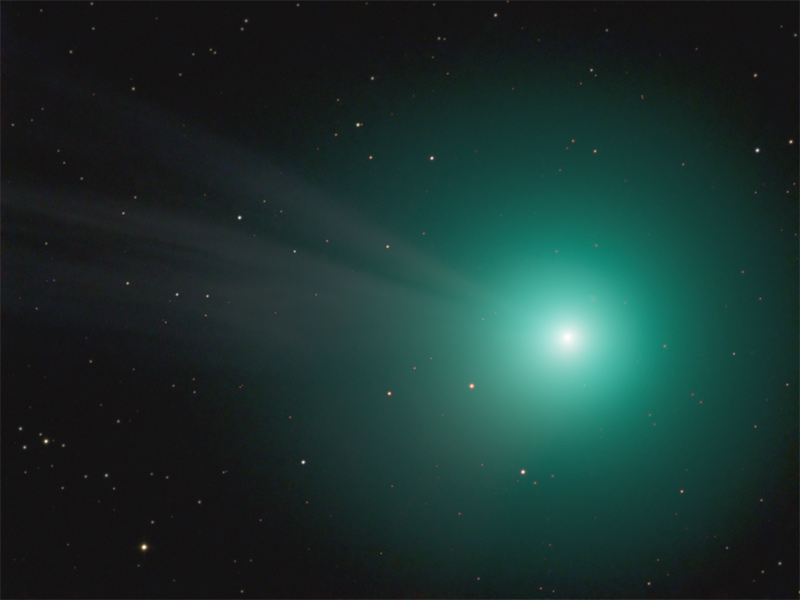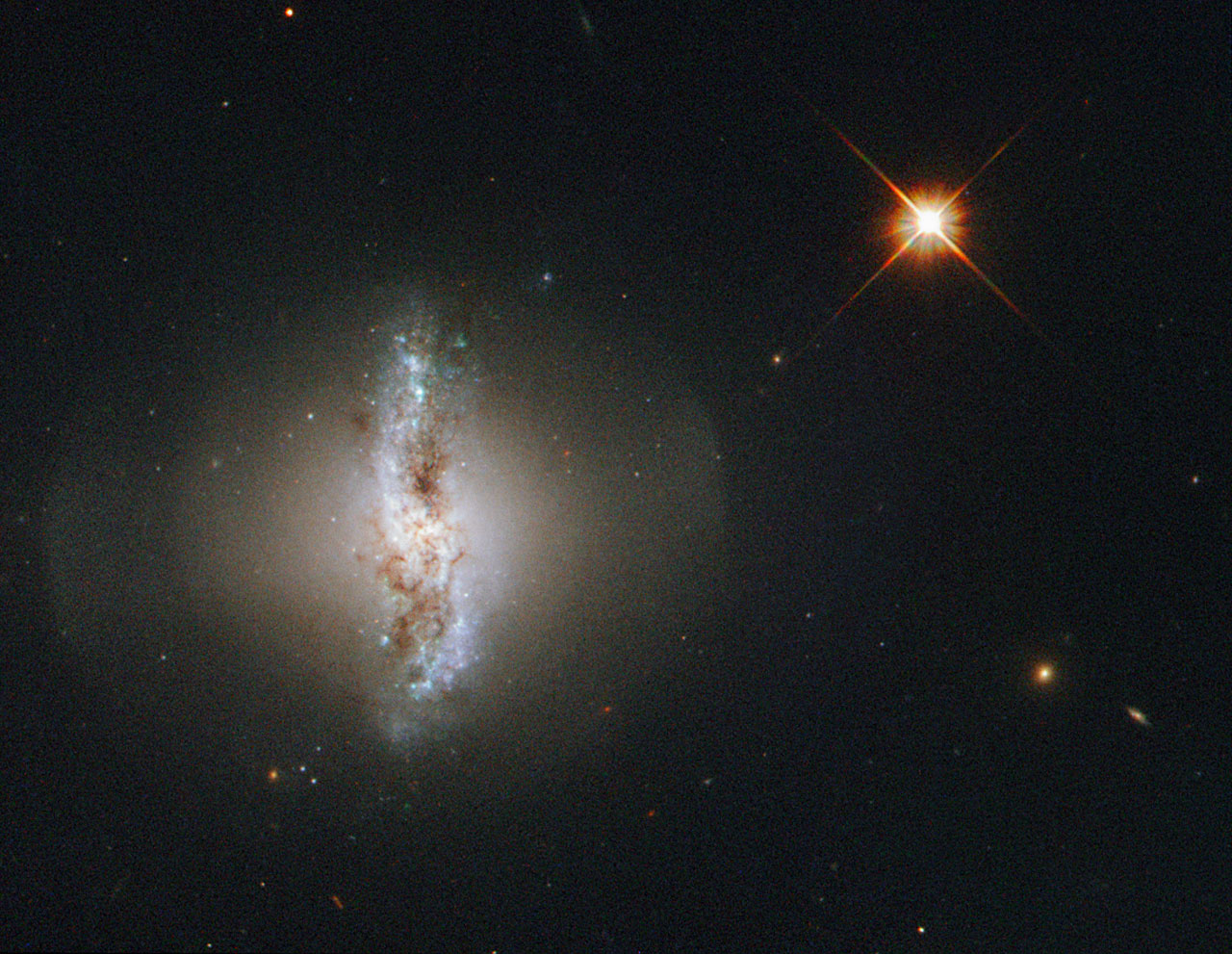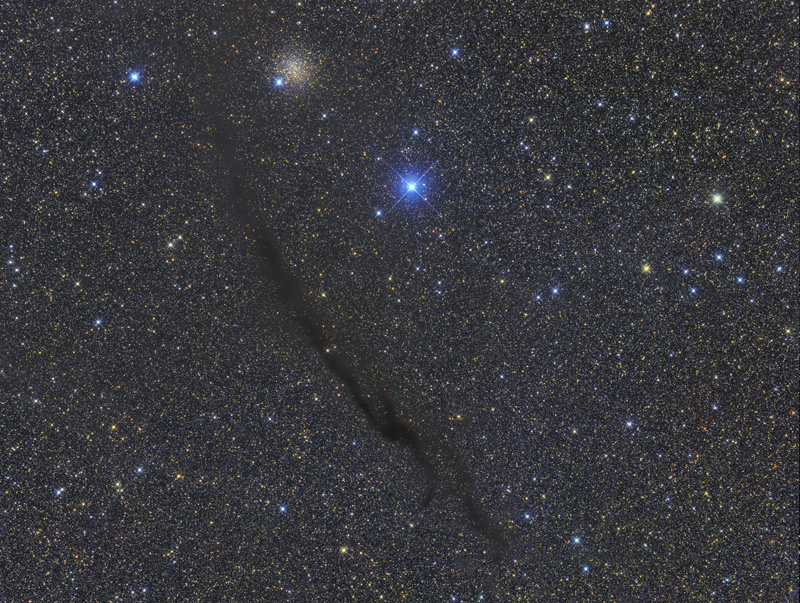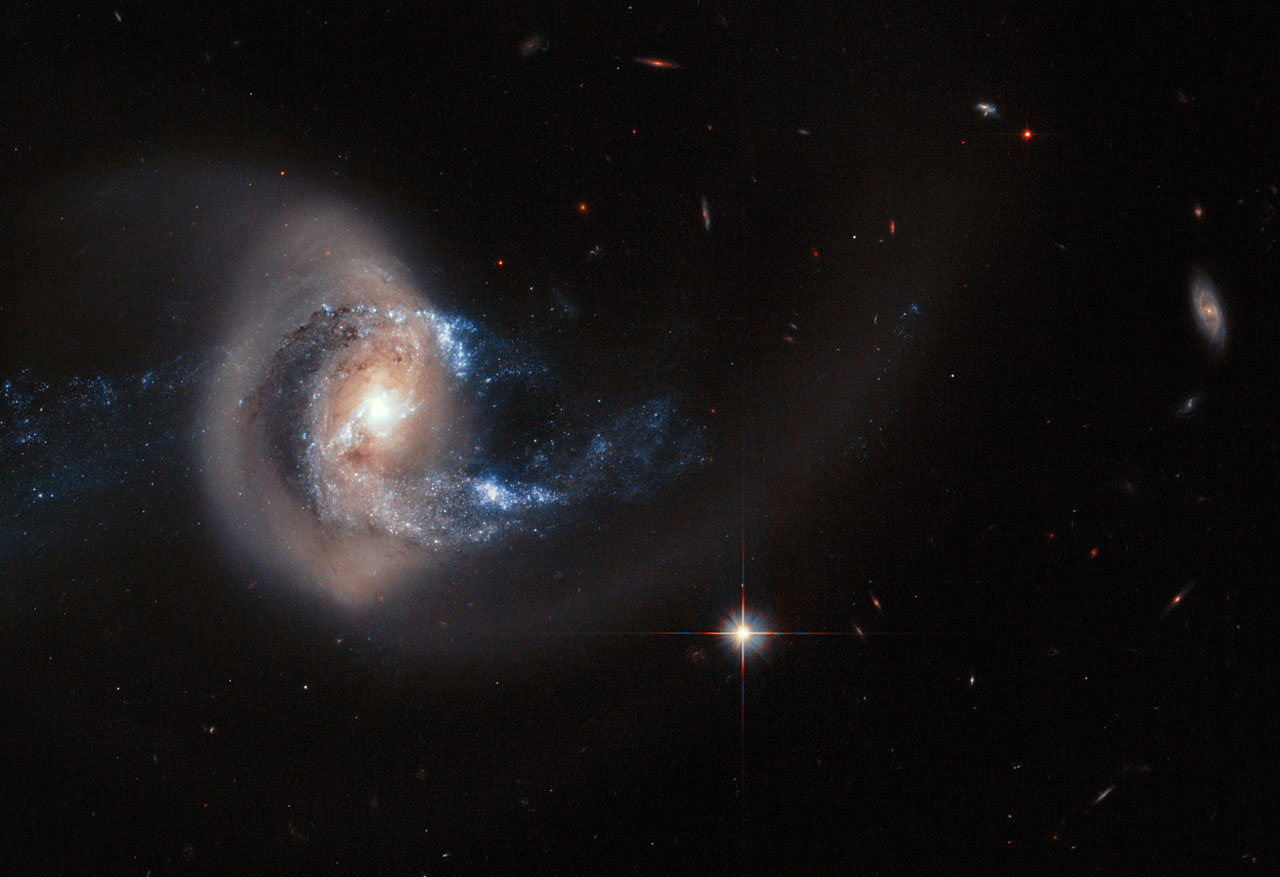Page 2 of 2
ESA/HEIC: The Third Way of Galaxies (NGC 6861)
Posted: Mon Jan 12, 2015 3:37 pm
by bystander
The Third Way of Galaxies
ESA Hubble POTW | 2015 Jan 12
The subject of this image is
NGC 6861, a galaxy discovered in 1826 by the Scottish astronomer
James Dunlop. Almost two centuries later we now know that NGC 6861 is the second brightest member of a group of at least a dozen galaxies called the
Telescopium Group — otherwise known as the NGC 6868 Group — in the small constellation of
Telescopium (
The Telescope).
This NASA/ESA Hubble Space Telescope view shows some important details of NGC 6861. One of the most prominent features is the disc of dark bands circling the centre of the galaxy. These dust lanes are a result of large clouds of dust particles obscuring the light emitted by the stars behind them.
Dust lanes are very useful for working out whether we are seeing the galaxy disc edge-on, face-on or, as is the case for NGC 6861, somewhat in the middle. Dust lanes like these are typical of a
spiral galaxy. The dust lanes are embedded in a white oval shape, which is made up of huge numbers of stars orbiting the centre of the galaxy. This oval is, rather puzzlingly, typical of an
elliptical galaxy.
So which is it — spiral or elliptical? The answer is neither! NGC 6861 does not belong to either the spiral or the elliptical family of galaxies. It is a
lenticular galaxy, a family which has features of both spirals and ellipticals. ...
Re: Found Images: 2015 January
Posted: Wed Jan 14, 2015 11:32 am
by starsurfer
Sh2-80
http://www.capella-observatory.com/Imag ... SH2-80.htm
Copyright: Josef Pöpsel and Stefan Binnewies
This Wolf Rayet nebula is associated with the Wolf Rayet star WR 124 (or QR Sagittae). It is also known as M1-67 and has been mistaken for a planetary nebula in the past.
Re: Found Images: 2015 January
Posted: Thu Jan 15, 2015 3:24 pm
by starsurfer
Re: Found Images: 2015 January
Posted: Thu Jan 15, 2015 4:50 pm
by iko
Zodiacal Light vs Milky Way
http://cdn.astrobin.com/images/thumbs/8 ... ermark.jpg

Two light beams pointing to infinity, are the Zodiacal Light facing the Milky Way ... Photographed in Morella, Castellón (Spain) Federico Margalef (Iko)
Re: Found Images: 2015 January
Posted: Thu Jan 15, 2015 5:01 pm
by iko
Zodiacal Bridge and Comet C/2014 Q2 Lovejoy
http://cdn.astrobin.com/images/thumbs/4 ... ermark.jpg

It is very difficult to see the Zodiacal Bridge but seeing as a Comet C / 2014 Q2 Lovejoy is something magical ... Photographed in Morella, Castellón (Spain) Federico Margalef (Iko)
Re: Found Images: 2015 January
Posted: Fri Jan 16, 2015 12:44 pm
by starsurfer
Re: Found Images: 2015 January
Posted: Mon Jan 19, 2015 1:47 pm
by starsurfer
ESA/HEIC: Dust Filaments of NGC 4217
Posted: Mon Jan 19, 2015 4:02 pm
by bystander
Dust Filaments of NGC 4217
ESA Hubble Picture of the Week | 2015 Jan 19
In this image the NASA/ESA Hubble Space Telescope takes a close look at the
spiral galaxy NGC 4217, 60 million light-years away. The galaxy is seen almost perfectly edge on and is a perfect candidate for studying the nature of extraplanar dust structures — the patterns of gas and dust above and below the plane on the galaxy, seen here as brown wisps coming off
NGC 4217.
These tentacle-like filaments are visible in the Hubble image only because the contrast with their surroundings is so high. This implies that the structures are denser than their surroundings. The image shows dozens of dust structures some of which reach as far as 7000 light-years away from the central plane. Typically the structures have a length of about 1000 light-years and are about 400 light-years in width.
Some of the dust filaments are round or irregular clouds, others are vertical columns, looplike structures or vertical cones. These structures can help astronomers to identify the mechanisms responsible for the ejection of gas and dust from the galactic plane of spiral galaxies and reveal information on the transport of the
interstellar medium to large distances away from galactic discs.
The properties of the observed dust structures in NGC 4217 suggest that the gas and dust was driven out of the midplane of the galaxy by powerful
stellar winds resulting from
supernovae — explosions that mark the deaths of massive stars.
Re: Found Images: 2015 January
Posted: Tue Jan 20, 2015 2:48 pm
by starsurfer
Re: Found Images: 2015 January
Posted: Wed Jan 21, 2015 10:35 am
by starsurfer
M80
http://www.chart32.de/index.php/object-list/item/131
Copyright: CHART32
Processing: Bernd Flach-Wilken
Re: Found Images: 2015 January
Posted: Thu Jan 22, 2015 8:51 pm
by starsurfer
Re: Found Images: 2015 January
Posted: Fri Jan 23, 2015 7:31 pm
by starsurfer
Comet Lovejoy
http://www.caelumobservatory.com/gallery/lovejoy.shtml
Copyright: Adam Block/Mount Lemmon SkyCenter/University of Arizona
ESA/HEIC: The Polar Ring of Arp 230
Posted: Mon Jan 26, 2015 6:25 pm
by bystander
The Polar Ring of Arp 230
ESA Hubble Picture of the Week | 2015 Jan 26
This Picture of the Week shows
Arp 230, also known as
IC 51, observed by the NASA/ESA Hubble Space Telescope.
Arp 230 is a galaxy of an uncommon or peculiar shape, and is therefore part of the
Atlas of Peculiar Galaxies produced by
Halton Arp. Its irregular shape is thought to be the result of a violent collision with another galaxy sometime in the past. The collision could also be held responsible for the formation of the galaxy’s polar ring.
The outer ring surrounding the galaxy consists of gas and stars and rotates over the poles of the galaxy. It is thought that the orbit of the smaller of the two galaxies that created Arp 230 was perpendicular to the disc of the second, larger galaxy when they collided. In the process of merging the smaller galaxy would have been ripped apart and may have formed the polar ring structure astronomers can observe today.
Arp 230 is quite small for a lenticular galaxy, so the two original galaxies forming it must both have been smaller than the Milky Way.
Re: Found Images: 2015 January
Posted: Mon Jan 26, 2015 7:41 pm
by starsurfer
Dark Doodad
http://www.astrostudio.at/1_Deep%20Sky% ... GC4372.jpg
Copyright: Gerald Rhemann
The globular cluster is NGC 4372.
Re: ESA/HEIC: The Polar Ring of Arp 230
Posted: Tue Jan 27, 2015 9:17 am
by starsurfer
bystander wrote:The Polar Ring of Arp 230
ESA Hubble Picture of the Week | 2015 Jan 26
This Picture of the Week shows
Arp 230, also known as
IC 51, observed by the NASA/ESA Hubble Space Telescope.
Arp 230 is a galaxy of an uncommon or peculiar shape, and is therefore part of the
Atlas of Peculiar Galaxies produced by
Halton Arp. Its irregular shape is thought to be the result of a violent collision with another galaxy sometime in the past. The collision could also be held responsible for the formation of the galaxy’s polar ring.
The outer ring surrounding the galaxy consists of gas and stars and rotates over the poles of the galaxy. It is thought that the orbit of the smaller of the two galaxies that created Arp 230 was perpendicular to the disc of the second, larger galaxy when they collided. In the process of merging the smaller galaxy would have been ripped apart and may have formed the polar ring structure astronomers can observe today.
Arp 230 is quite small for a lenticular galaxy, so the two original galaxies forming it must both have been smaller than the Milky Way.
I posted geckzilla's version of this and both are lovely! I think a wider view shows a tidal tail associated with it.
Re: Found Images: 2015 January
Posted: Tue Jan 27, 2015 9:26 am
by starsurfer
NGC 1333 widefield
http://www.astrosurf.com/comolli/d184.htm
Copyright: Lorenzo Comolli and Edoardo Radice
The reflection nebula at the bottom is vdB13 and the one near the left is vdB16 and both are in the neighbouring constellation of Aries.
Re: ESA/HEIC: The Polar Ring of Arp 230
Posted: Tue Jan 27, 2015 5:58 pm
by Ann
bystander wrote:The Polar Ring of Arp 230
ESA Hubble Picture of the Week | 2015 Jan 26
This Picture of the Week shows
Arp 230, also known as
IC 51, observed by the NASA/ESA Hubble Space Telescope.
Arp 230 is a galaxy of an uncommon or peculiar shape, and is therefore part of the
Atlas of Peculiar Galaxies produced by
Halton Arp. Its irregular shape is thought to be the result of a violent collision with another galaxy sometime in the past. The collision could also be held responsible for the formation of the galaxy’s polar ring.
The outer ring surrounding the galaxy consists of gas and stars and rotates over the poles of the galaxy. It is thought that the orbit of the smaller of the two galaxies that created Arp 230 was perpendicular to the disc of the second, larger galaxy when they collided. In the process of merging the smaller galaxy would have been ripped apart and may have formed the polar ring structure astronomers can observe today.
Arp 230 is quite small for a lenticular galaxy, so the two original galaxies forming it must both have been smaller than the Milky Way.
Wow, what a fascinating galaxy! The polar ring appears to be richly starforming, and the elliptical galaxies shows a few splendid shells!
Tell me, Geck, since you processed a version of this image, was there a lot of UV light coming from the polar ring?
Ann
Re: Found Images: 2015 January
Posted: Tue Jan 27, 2015 7:40 pm
by geckzilla
For whatever reason I didn't use any of the UV filters on my version. I clearly dropped the ball on it. But the polar ring is indeed quite luminous at 336 nm just from looking at the preview image in the archive. You can see the fainter shell (it's in apparent close proximity to the bright star) better in my image (
link for compare). Mine just cut off that little background galaxy in the lower right. There's no extra tidal tail in the ESA version.
ESO: The Mouth of the Beast (CG4)
Posted: Wed Jan 28, 2015 3:52 pm
by bystander
The Mouth of the Beast
VLT images cometary globule CG4
ESO Photo Release | 2015 Jan 28
Like the gaping mouth of a gigantic celestial creature, the cometary globule CG4 glows menacingly in this new image from ESO’s Very Large Telescope. Although it appears to be big and bright in this picture, this is actually a faint nebula, which makes it very hard for amateur astronomers to spot. The exact nature of CG4 remains a mystery.
In 1976 several elongated comet-like objects were discovered on pictures taken with the UK Schmidt Telescope in Australia. Because of their appearance, they became known as cometary globules even though they have nothing in common with comets. They were all located in a huge patch of glowing gas called the
Gum Nebula. They had dense, dark, dusty heads and long, faint tails, which were generally pointing away from the
Vela supernova remnant located at the centre of the Gum Nebula. Although these objects are relatively close by, it took astronomers a long time to find them as they glow very dimly and are therefore hard to detect.
The object shown in this new picture,
CG4, which is also sometimes referred to as God’s Hand, is one of these cometary globules. It is located about 1300 light-years from Earth in the constellation of
Puppis (
The Poop, or Stern).
The head of CG4, which is the part visible on this image and resembles the head of the gigantic beast, has a diameter of 1.5 light-years. The tail of the globule — which extends downwards and is not visible in the image — is about eight light-years long. By astronomical standards this makes it a comparatively small cloud.
The relatively small size is a general feature of cometary globules. All of the cometary globules found so far are isolated, relatively small clouds of neutral gas and dust within the Milky Way, which are surrounded by hot ionised material. ...
HEIC: The Tell-tale Signs of a Galactic Merger (NGC 7714)
Posted: Thu Jan 29, 2015 4:04 pm
by bystander
The Tell-tale Signs of a Galactic Merger
ESA Hubble Photo Release | 2015 Jan 29
The NASA/ESA Hubble Space Telescope has captured this striking view of spiral galaxy
NGC 7714. This galaxy has drifted too close to another nearby galaxy and the dramatic interaction has twisted its spiral arms out of shape, dragged streams of material out into space, and triggered bright bursts of star formation.
NGC 7714 is a spiral galaxy at 100 million light-years from Earth — a relatively close neighbour in cosmic terms.
The galaxy has witnessed some violent and dramatic events in its recent past. Tell-tale signs of this brutality can be seen in NGC 7714's strangely shaped arms, and in the smoky golden haze that stretches out from the galactic centre.
So what caused this disfigurement? The culprit is a smaller companion named
NGC 7715, which lies just out of the frame of this image — but is visible in the
wider-field DSS image. The two galaxies (
Arp 284) drifted too close together between 100 and 200 million years ago, and began to drag at and disrupt one another’s structure and shape.
As a result, a ring and two long tails of stars have emerged from NGC 7714, creating a bridge between the two galaxies. This bridge acts as a pipeline, funnelling material from NGC 7715 towards its larger companion and feeding bursts of star formation. Most of the star-forming activity is concentrated at the bright galactic centre, although the whole galaxy is sparking new stars.
Astronomers characterise NGC 7714 as a typical Wolf-Rayet
starburst galaxy. This is due to the stars within it; a large number of the new stars are of the
Wolf-Rayet type — extremely hot and bright stars that begin their lives with dozens of times the mass of the Sun, but lose most of it very quickly via powerful winds.
This Hubble image is a composite of data capturing a broad range of wavelengths, revealing the correlation of the gas clouds and stars in the galaxy. This new picture not only reveals the intricate structure of NGC 7714, but also shows many other objects that are much further away. These background galaxies resemble faint smudges of light, some of them with spiral forms.
Hubble Spies a Loopy Galaxy
NASA | STScI | HubbleSite | 2015 Jan 29
Re: Found Images: 2015 January
Posted: Fri Jan 30, 2015 1:21 am
by Ann
Oh, that's such a cool galaxy!

I checked NGC 7714 against Principal Galaxy Catalog. It is a very ultraviolet galaxy indeed. But fascinatingly, the
DSS widefield image shows that NGC 7715, which is interacting with NGC 7714 and causing all that star formation, is actually bluer (more dominated by 400 nm to 500 nm light) than its larger "merger companion". Apart from the fact that the Magellanic Clouds are not in the process of actually merging - at least they haven't proceeded very far along that path - the two Magellanic Clouds do show some resemblance to the two components of Arp 284. The Small Magellanic Cloud may be feeding some gas to the Large Cloud. The SMC is actually more dominated by blue light (in the 400 nm to 500 nm optical range) than the LMC, but the Large Cloud is by far the most ultraviolet one.
Ann
Re: Found Images: 2015 January
Posted: Fri Jan 30, 2015 1:10 pm
by starsurfer
geckzilla wrote:There's no extra tidal tail in the ESA version.
The field of view of the Hubble image doesn't include a tidal tail but there is one visible in images with a larger field of view. I remember seeing an image that isn't available online anymore.
Re: ESA/HEIC: The Tell-tale Signs of a Galactic Merger (NGC
Posted: Fri Jan 30, 2015 1:14 pm
by starsurfer
bystander wrote:The Tell-tale Signs of a Galactic Merger
ESA Hubble Photo Release | 2015 Jan 29
The NASA/ESA Hubble Space Telescope has captured this striking view of spiral galaxy
NGC 7714. This galaxy has drifted too close to another nearby galaxy and the dramatic interaction has twisted its spiral arms out of shape, dragged streams of material out into space, and triggered bright bursts of star formation.
NGC 7714 is a spiral galaxy at 100 million light-years from Earth — a relatively close neighbour in cosmic terms.
The galaxy has witnessed some violent and dramatic events in its recent past. Tell-tale signs of this brutality can be seen in NGC 7714's strangely shaped arms, and in the smoky golden haze that stretches out from the galactic centre.
So what caused this disfigurement? The culprit is a smaller companion named
NGC 7715, which lies just out of the frame of this image — but is visible in the
wider-field DSS image. The two galaxies (
Arp 284) drifted too close together between 100 and 200 million years ago, and began to drag at and disrupt one another’s structure and shape.
As a result, a ring and two long tails of stars have emerged from NGC 7714, creating a bridge between the two galaxies. This bridge acts as a pipeline, funnelling material from NGC 7715 towards its larger companion and feeding bursts of star formation. Most of the star-forming activity is concentrated at the bright galactic centre, although the whole galaxy is sparking new stars.
Astronomers characterise NGC 7714 as a typical Wolf-Rayet
starburst galaxy. This is due to the stars within it; a large number of the new stars are of the
Wolf-Rayet type — extremely hot and bright stars that begin their lives with dozens of times the mass of the Sun, but lose most of it very quickly via powerful winds.
This Hubble image is a composite of data capturing a broad range of wavelengths, revealing the correlation of the gas clouds and stars in the galaxy. This new picture not only reveals the intricate structure of NGC 7714, but also shows many other objects that are much further away. These background galaxies resemble faint smudges of light, some of them with spiral forms.
Hubble Spies a Loopy Galaxy
NASA | STScI | HubbleSite | 2015 Jan 29
I'm a big fan of peculiar galaxies and particularly love the Arp Atlas and the lesser known southern Arp Madore catalogue. This image did indeed wow me and it has one of my favourite features of peculiar and interacting galaxies, tidal streams!
It would have been nice if the HST image was a mosaic that also included NGC 7715 but seeing just NGC 7714 on its own in such exquisite resolution is more than enough for me! I also believe Ha shows many HII regions in this galaxy.
An
amateur image by Rick Johnson shows both galaxies.
Re: Found Images: 2015 January
Posted: Fri Jan 30, 2015 1:19 pm
by starsurfer
Re: Found Images: 2015 January
Posted: Fri Jan 30, 2015 5:38 pm
by philto
Scrat on Sun...and his nuts !!
regards
image © Philippe TOSI
